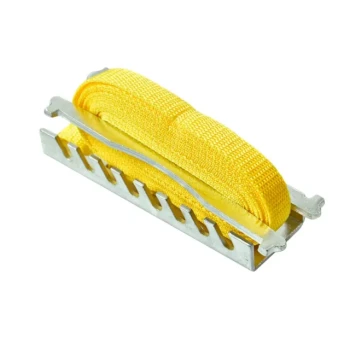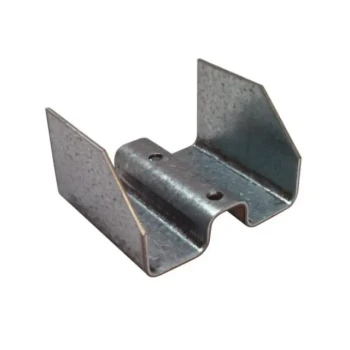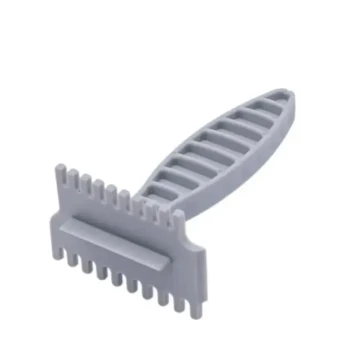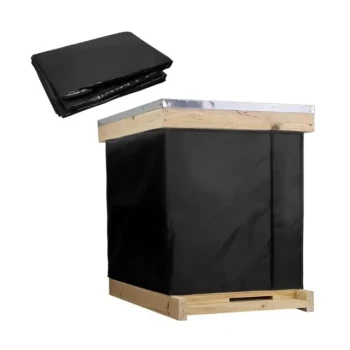Foundationless beekeeping is a practice that allows honey bees to build their honeycomb naturally, without the guidance of a pre-made wax or plastic foundation. Instead of providing a pre-stamped hexagonal pattern, the beekeeper gives the bees an empty frame, often with a small guide, empowering them to construct the comb using their own instincts and preferred cell sizes.
This method trades the predictability of standardized beekeeping for a more natural hive environment. Success hinges on understanding how to guide the bees' initial construction to prevent structural problems like cross-comb.
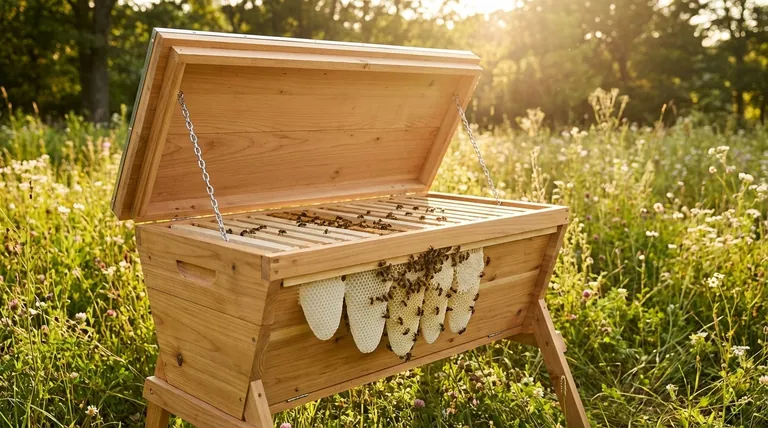
The Philosophy: Why Choose Foundationless?
Foundationless beekeeping is more than a technique; it's a choice to prioritize the bees' natural behavior over the beekeeper's convenience. The standard foundation was introduced to create uniform, stable combs for large-scale operations, but forgoing it offers distinct advantages.
Emulating Natural Bee Behavior
In nature, bees build comb with cell sizes that vary for different purposes, such as raising worker brood, drone brood, or storing honey. Foundationless beekeeping allows bees to determine these sizes themselves, creating a more natural internal hive structure.
Avoiding Plastics and Contaminants
Many beekeepers choose this method to avoid introducing plastic into the hive. Even commercial wax foundation can accumulate pesticides and chemicals over time, which can then be incorporated into the bees' new wax. Building their own comb ensures it is pure and contaminant-free.
Simplified Honeycomb Harvesting
For those interested in producing cut-comb honey, the foundationless method is ideal. Since there is no plastic or thick wax mid-rib, the entire section of honeycomb is edible and can be easily cut from the frame.
Enhanced Hive Visibility
Freshly drawn natural comb is pure white, which creates a high-contrast background. This makes it significantly easier for the beekeeper to spot tiny eggs and young larvae during hive inspections.
The Practical Methods: How to Get Started
Implementing foundationless beekeeping is straightforward, but it requires careful attention to a few key details to guide the bees effectively.
For Langstroth Hives
In standard Langstroth equipment, you can use either special foundationless wooden frames with a beveled or ridged top bar or standard frames with a starter strip. This strip can be a thin line of wax foundation, a wooden popsicle stick, or even just a line of melted beeswax along the top bar's guide.
For Top Bar and Warre Hives
These hive types are inherently designed for foundationless beekeeping. They use simple top bars instead of full frames, and bees naturally build their comb down from these bars. The principles of guidance remain the same.
The Primary Risk: Understanding and Preventing Cross-Comb
The single greatest challenge in foundationless beekeeping is cross-comb, where bees build comb across multiple frames instead of straight down within a single frame. This makes hive inspections nearly impossible without destroying the comb and potentially harming the queen.
What Causes Cross-Comb?
Cross-comb occurs when bees lack a clear guide or have too much empty space. Without direction, their building can become disorganized, welding frames together into an unmanageable block.
Tactic 1: Ensure the Hive is Perfectly Level
A hive that is not level side-to-side can encourage bees to build their comb at an angle, leading it to attach to an adjacent frame. This is the most critical and easiest step to prevent issues.
Tactic 2: Use All Available Frame Slots
Always use the correct number of frames for your box (e.g., 10 frames in a 10-frame box). Leaving gaps gives bees unstructured space, which is a primary invitation for building cross-comb.
Tactic 3: Use "Bait" or Guide Combs
The most effective way to ensure straight comb is to place a foundationless frame between two frames of existing, straight, drawn-out honeycomb. The established combs act as a powerful guide that the bees will follow.
The Art of Correction
Check on new foundationless frames frequently as they are being built. If you spot comb going slightly crooked while the wax is still new and soft, you can often gently push it back into place. For more serious errors, you can cut the comb and reattach it to the frame straight using rubber bands or zip-ties until the bees secure it.
Making the Right Choice for Your Apiary
Deciding whether to go foundationless depends entirely on your beekeeping goals and your tolerance for hands-on management.
- If you are a new beekeeper: Start by alternating foundationless frames with frames that have foundation. This provides strong guides, dramatically reduces the risk of cross-comb, and allows you to learn the process gradually.
- If your primary focus is natural beekeeping or cut-comb honey: Foundationless is the ideal method, allowing for pure, fully edible honeycomb and letting bees control their hive environment.
- If you prioritize ease of management and maximum stability: Using traditional foundation ensures straight, durable combs that are predictable and require less frequent monitoring to prevent structural issues.
By understanding these principles, you can confidently decide how to integrate this natural approach into your own apiary.
Summary Table:
| Aspect | Key Takeaway |
|---|---|
| Definition | Beekeeping without pre-made wax/plastic foundation, allowing bees to build comb naturally. |
| Primary Benefit | Promotes natural bee behavior, pure wax, and is ideal for cut-comb honey production. |
| Primary Risk | Cross-comb, where bees build comb across multiple frames, making inspections difficult. |
| Best For | Beekeepers focused on natural methods, cut-comb honey, or avoiding hive contaminants. |
| Starting Tip | For beginners, alternate foundationless frames with frames containing foundation to guide bees. |
Ready to adopt a more natural approach to beekeeping?
Whether you're a commercial apiary or a distributor, HONESTBEE supplies the durable, high-quality equipment you need to succeed with foundationless or traditional methods. From foundationless frames to essential hive tools, our wholesale-focused operations ensure you get the reliable gear that supports healthy, productive hives.
Contact our experts today to discuss your apiary's needs and explore our full product catalog.
Visual Guide
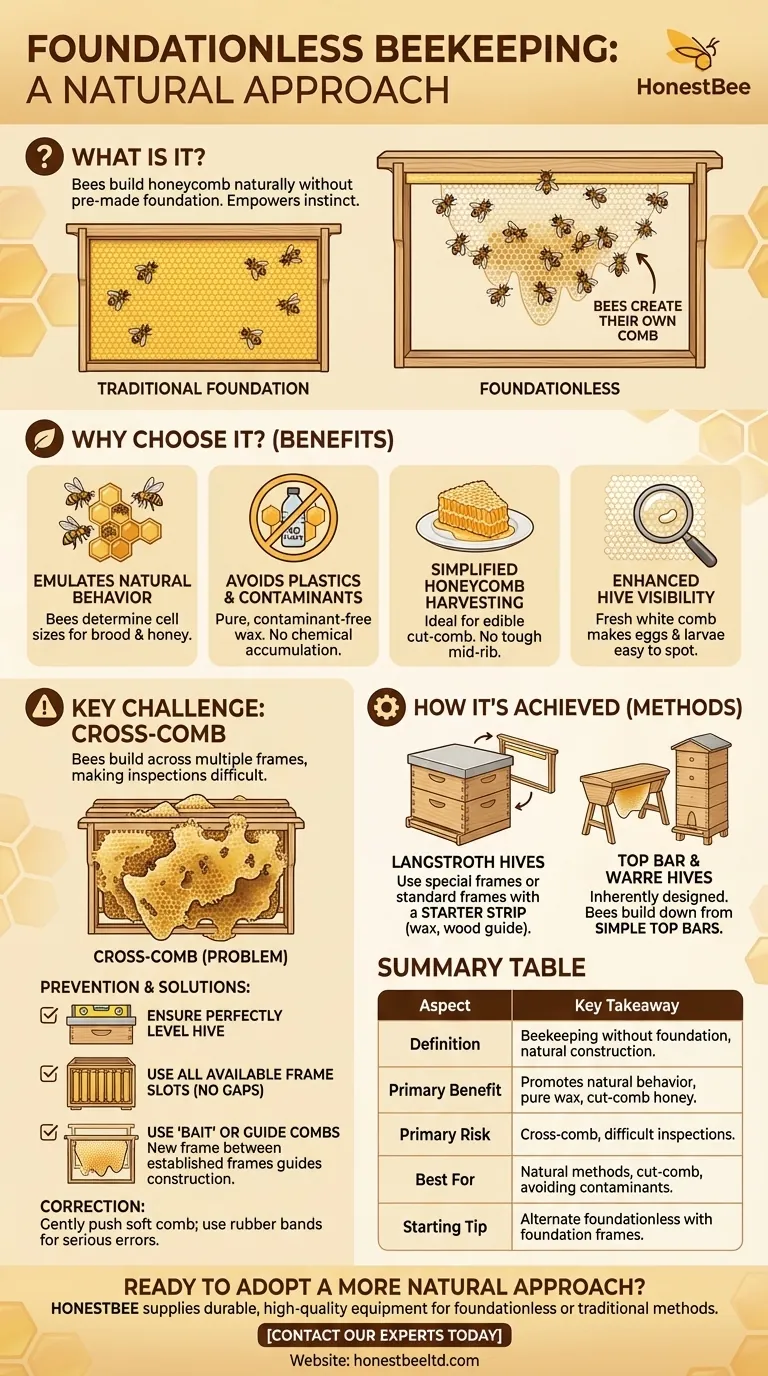
Related Products
- Long Langstroth Style Horizontal Top Bar Hive for Wholesale
- HONESTBEE Professional Bee Frame Machine for Side Bar Shaping
- Professional Galvanized Hive Strap with Secure Locking Buckle for Beekeeping
- Professional Wide Blade Honey Scraper for Beekeeping and Honey Processing
- Stainless Steel Bee Hive Frame Wire for Beekeeping
People Also Ask
- How does the top bar hive help control varroa mites? A Natural Approach to Mite Management
- What are the box management requirements for a top bar hive vs. Langstroth? Choose Your Hive Strategy
- How does the design of a top bar hive benefit beekeepers? Ergonomic & Natural Beekeeping for Hobbyists
- How are entrances designed in top bar hives? Master Beehive Layout for Maximum Honey
- What are the benefits of a top bar hive? A Natural, Low-Impact Approach to Beekeeping


